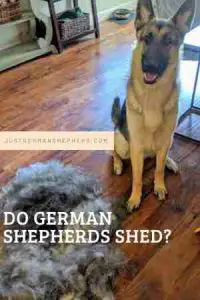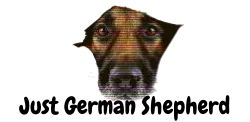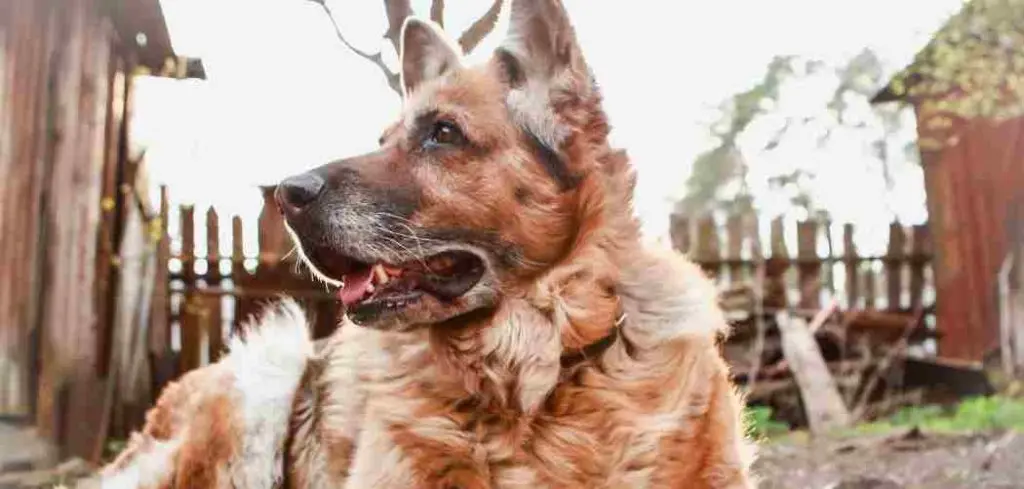
Shedding.
Do German Shepherds Shed? German Shepherds do shed. A lot in fact. There is no sugar coating it. Their fur gets everywhere and seems to multiply all on its own. There is a reason they are affectionately known as “German Shedders”.
Owning a German Shepherd can be a daily sweeping and vacuuming exercise but there are many factors that contribute to why and how much a German Shepherd sheds.
Table of Contents
Reasons German Shepherds Shed
There are many reasons German Shepherds shed including the seasons, their age, health, the quality of their diet, and hormone levels. Appropriate grooming, regular skin checks, and good flea, tick and worm treatments can all help to reduce shedding.
German Shepherd Coat
German Shepherds have what is commonly called a ‘double coat’. They have a thick and fluffy undercoat, that is usually white in color and has waterproof properties. This shows through when you part their hair. Their outer coat – the guard coat- is a thick, coarse and straight coat, and lies flat against the body.
They can either be long or short coated, but all German Shepherds shed. In fact, all breeds shed. Some shed less than others, but there is no such thing as a hypoallergenic breed. We will cover that more later.
Your German Shepherd will shed all year long, however, he is technically a seasonal shedder. Shedding is affected by hormones and hormones are affected by light levels. As the days grow shorter and the temperature drops, your German Shepherd will start growing his winter coat. To do that, he needs to lose the last of his summer coat. This burst of shedding happens at the beginning of fall and last several weeks.
In the springtime, he no longer needs that thick winter coat, so it is time to get rid of it. He will start ‘blowing out’, the term given to the spring shedding. It will look as though he is shedding his entire coat all at once, but do not worry; blowing out only last a few weeks and is completely normal.
Puppy Coat
German Shepherd puppies are basically giant balls of fur on legs! Puppies are not born with the ability to regulate their body temperature and they do not have sweat glands like we do, so they need a thick coat to keep them warm in winter. In the summer, their double coat traps cool air, keeping their body temperature down. Puppies will sleep close to their mother or in a puppy huddle with their littermates to share body heat.
Between the ages of 4 and 6 months, puppies will start to grow their adult coat. That means they have to lose their puppy coat. Like ‘blowing out’, puppy shedding can last for several weeks, but is a normal process.
You can help the process along by giving then a short and gentle grooming session daily. This will ensure any loose hairs are removed. Do not apply too much pressure, as this can damage the skin, which may lead to further shedding.
It is also a good time to get them used to being groomed in a calm and relaxed way. Puppies love a fuss so slowly introducing a brush or comb to their massage sessions will be stress-free.
Stress
Dogs are very good at hiding when they are stressed. It is a natural leftover from their wild ancestors. Showing weakness is not good for survival. Excessive or sudden shedding can be a sign that your dog is feeling stressed or anxious. Signs to look for:
- Excessive panting
- Drooling
- Pacing
- Avoidance or hiding
- Lethargy
- Loss of appetite
- Tail between the legs
- Destruction behavior such as chewing
- Nervous urination
You will need to find the source of your dog’s anxiety to begin solving the problem of the sudden shedding. Common causes for stress are loud noises, illness, moving to a new house or introducing a new pet or baby into the household.
Making a list of anything that has changed in recent months will help you pinpoint the cause. In the meantime, you can speak to your vet about calming plug-ins. They slowly released pheromones that will help reduce anxiety and promote a calming atmosphere.
Allergies or Intolerances
Just like humans, dogs can develop allergies, either dietary or environmental. Many allergies cause skin irritation, which is itchy. Itching causes shedding. It’s a vicious cycle! Look for symptoms common with skin complaints:
- Scratching
- Red skin or skin sores
- Hair loss/patchiness
Your dog’s allergy could be to food or it could be environmental. You will need to seek veterinary advice to get a definitive diagnosis. Lactose, found in milk, is a common allergy for dogs. Some dogs can also be sensitive to fillers like wheat or grains, which are used in a lot of commercial dog food.
Your vet may ask you to remove certain foods or ingredients from your dog’s diet and slowly add them back in one at a time. If it is a food allergy, the shedding and skin irritation will return when the relevant food is put back into the regular diet.
There are lots of specially formulated diets available for dogs with sensitive stomachs or digestive illnesses. Tackling this will help reduce excessive shedding.
Pregnancy and Neutering
Organs related to breeding produce and require a lot of hormones. These hormones have a direct effect on the skin. Sudden rises or falls in these hormones can cause sudden bursts of shedding.
After surgery for neutering, your dog’s hormone levels will dip suddenly, causing a period of shedding. This should only last for a couple of weeks and their coat should be in the same good condition when the shedding stops.
Pregnancy shedding can last several months. When a bitch first falls pregnant, her body has high levels of certain hormones needed to support the puppies’ growth. Due to these hormone levels remaining high throughout pregnancy, you can expect an increase in shedding during this time.
After birth, these hormones will start dropping off, however, another hormone increases. Oxytocin also called the ‘love hormone’ triggers the bonding behavior exhibited by the mother. Oxytocin also has an effect on the skin. After birth, increased shedding can last for a few months, but this is normal and nothing to worry about.
Fleas, Ticks and Worms
Sometimes excessive shedding, patchy hair loss and skin irritation can be caused by parasites. Getting these parasites under control and treating the skin will help to restore the health and strength of the skin and hair follicles.
Fleas are nasty little nippers. They are small jumping insects that live in the coat of your dog and on furniture he comes into contact with. That includes sofas, pet and human bedding, carpets and curtains. One female flea can lay 500 eggs per day! To prevent fleas, you should have your dog on a monthly flea prevention treatment. This can be administered as a spot-on solution, in the form of tablets or fitting a flea collar.
If you find that your dog catches fleas, you will need to treat your home as well as your dog. Your furniture and carpets will need to be heat treated and steamed to kill any eggs. You will also need to put your clothes and bedding through a hot washing machine cycle.
Speak with your vet about effective flea shampoo and also anything that will relieve the skin irritation they cause. Some dogs can be allergic to flea saliva. This can cause their hair to fall out in patches and they will scratch or bite at their skin.
Ticks are similar to flea in that they feed off blood, but a tick will bite once and attach itself to your dog’s skin, where it will feed continuously. This can cause several medical issues for your dog. You may notice that your dog seems sluggish. This is due to the blood loss from the tick. The place where the tick attaches to your dog will be red and irritated. In rare circumstances, certain female ticks can cause paralysis due to a toxin they produce during feeding.
Ticks spread Lyme disease. This can cause your dog to develop arthritis or swelling in his joints, which can be very painful. They can also cause Rocky Mountain spotted fever, which shows as lameness and fever. Ticks can easily be picked up when your dog is outdoors and are more common during warm weather.
You can help prevent your dog getting ticks by keeping them on a regular tick control routine. Most flea treatments also deal with ticks. Also, create a barrier between your yard and dense tree cover. 3 feet should be enough to stop ticks migrating.
Removing ticks from your dog should be done careful. Breaking the tick’s body can cause infection to spread and make your dog very sick. You will need a pair of fine-point tweezers. Do not use normal blunt edged tweezers or you risk tearing the tick.
Spread your dog’s fur and, using the tweezers, get a grip as close to your dog’s skin as possible. You will need to pull gently upwards in one smooth motion. This will prevent the mouthparts from separating from the tick’s body.
If you are unsure or have attempted and failed to remove a tick, take your dog to the vet. They will be able to remove it for you and check there has been no lasting damage to your dog’s health.
Worms are something all dogs have. Most are intestinal and feed off the nutrients from the food your dog eats. If your dog is not wormed regularly – every 3 months – worms can build up in his gut. This significantly reduces the amount of nutrients he can absorb. Those nutrients are important to skin elasticity and har follicle growth.
A heavy worm burden can cause dry and flaky skin, which your dog will want to scratch at to relieve the itching. The poor skin condition and the scratching cause hair to be shed and also cause patchiness and skin sores. This maintains the itchiness so your dog will not be able to resist scratching more.
Worming tablets should be given every 3 months to keep the worm burden at a manageable level. worming treatment never eliminate all the worms. A safe level of worms is not harmful to your dog. If you think he is suffering from a worm build up, make an appointment with your vet to have a thorough health check.
Do German Shepherds Shed?
How to control shedding
Getting shedding under control at home and dealing with regular shedding will do wonders for your anxiety levels. Nobody wants to be taking a lint roller to their clothes every day or having to unblock the dog hair stuck in the washing machine filter.
Never Shave Your Shepherd
Unless it is advised by your veterinarian due to health reasons, you should absolutely never shave your German Shepherd. They use their coats like climate control. Unlike us, they cannot sweat to lose body heat, so during the summer months, they trap cool air in between their outer coat and undercoat. This helps them stay cool.
During winter they double coat prevents heat loss from their body so they can stay warm and toasty. Shaving your German Shepherd means they will not be able to maintain a comfortable body temperature. This can cause stress, which in turn can lead to hair loss.
Once you shave your German Shepherd’s coat, it will not grow back the same as it was before. Their hair should only be shaved for medical reasons such as to treat an underlying skin complaint or for surgical purposes.
Grooming
You do not need to spend a fortune on grooming salons to keep the pesky pet hair at bay. During the shedding seasons, grooming your German Shepherd once a daily will help remove any loose hairs. For the rest of the year, a brush once a week should be enough.
It is the undercoat that causes most of the shedding so the brush you use needs to penetrate the thick outer coat. A comb or brush with long sturdy bristles is perfect for the job. You can get these from any pet store or online retailer.
Investing in a high powered dryer will be a godsend. They are not as powerful as the commercial dryers used by dog groomers, but they will blow most of the loose hair away very quickly. It is not recommended to use these dryers indoors unless you want a hair storm in your living room!
When you bath your dog, use a de-shedding shampoo and/or cream instead of a regular doggy shampoo. You can purchase these from your local pet store. Vet clinics will also sell them.
An occasional trip to the groomers will really make things easier for you. A professional wash and blow-dry and reduce shedding for up to 2 weeks, giving your vacuum a much-needed break.
Appliances
If you find your vacuum cleaner cannot cope with the amount of hair your fluffball is shedding, you should invest in a vacuum that has multiple power settings. Get online and read some reviews before you purchase. Not all vacuums are created equal and you need one that will not get blocked by endless rounds of hair.
There are always new gadgets on the market and the pet shedding game is big business. You can now purchase several varieties of ‘pet vacuums’. Essentially, it is a brush or comb head with a small collection cylinder attached. You brush your dog as normal, but the suction moves the loose hairs from your dogs coat into the cylinder. They are easy to empty and don’t require much charging time.
For larger dogs, you can also purchase a bigger version that plugs straight into a wall outlet. These options have bigger cylinders so can handle more hair, but they may be louder and more expensive that the hand help pet vacuums.
For the low shedding times of the year you can use a grooming glove. They look like a regular gardening glove, but the palm and fingers have a rubber coating with bristle-like ridges that bring loose hair to the surface.
Hypoallergenic Breeds
There has been a lot of debate and discussion over the last few decades regarding certain breeds that limit dog allergies or do not trigger them at all. Scientific research shows that all dogs shed hair, it is just that some do it more than others. Even breeds touted as safe for allergy sufferers shed. Poodles for instance, shed their hair on and off, but their loose hair gets caught in their curly coat so it is not noticeable.
Pet allergies are not caused by hair. They are caused by skin, saliva and/or dander. Dander is microscopic shedding of dead skin cells. It is this that a human allergy sufferer will have a reaction to. Having a ‘hypoallergenic’ breed will not protect from this.
Final Thoughts
If there was a contest of the worst shedding dog breed, German Shepherds would be contenders for the top spot. They shed all year long and have very thick coats. Owning a German Shepherd means you will get hairy. There is no escaping it.
Fortunately, there are ways to make life easier for you and your dog. If shedding suddenly becomes excessive, be sure to seek veterinary advice to rule out a medical cause. Keep a note of any behavioral changes, as well as any changes that have happened in the home. Sometimes, a simple thing can create stress, which leads to shedding.
You may notice increased shedding around Halloween, Bonfire Night, New Year’s Eve and Fourth of July when fireworks and loud noises are to be expected. Loud noises can cause heightened stress levels for dogs, which we know can lead to bouts of shedding.
Be sure to choose a high-quality diet and try to stick with white meats like chicken and turkey. They are easier for your German Shepherd to digest and have high levels of protein content, which boosts skin condition and hair growth.
No matter how hairy your home gets, just love your little or large furball!
Is your German Shepherd Shedding out of control? Any handy tips to ease the cleanup? Anything we’ve got factually incorrect in our article? We’d love to hear from you in the comments.
References
Doris W.Vredegoor BSca, Ton Willemse PhDb, Martin D.Chapman PhDc, Dick J.J.Heederik PhDa, Esmeralda J.M.Krop PhD, (2012) ‘Can f 1 levels in hair and homes of different dog breeds: Lack of evidence to describe any dog breed as hypoallergenic’, Journal of Allergy and Clinical Immunology, 130 (4), pp. 904-909.
Harvey, R.G., (1993). ‘Food allergy and dietary intolerance in dogs: a report of 25 cases’. Journal of Small Animal Practice, 34(4)
Nicholas, C. E. et al. (2011) ‘Dog Allergen Levels in Homes with Hypoallergenic Compared with Non-hypoallergenic Dogs’, American Journal of Rhinology & Allergy, 25(4)
Tieghi, C., Miller Jr, W.H., Scott, D.W. and Pasquinelli, G., (2003). ‘Medullary trichomalacia in 6 German shepherd dogs’. The Canadian Veterinary Journal, 44(2), p.132.
Watson, T.D., (1998). ‘Diet and skin disease in dogs and cats’. The Journal of nutrition, 128(12), pp.2783S-2789S.

